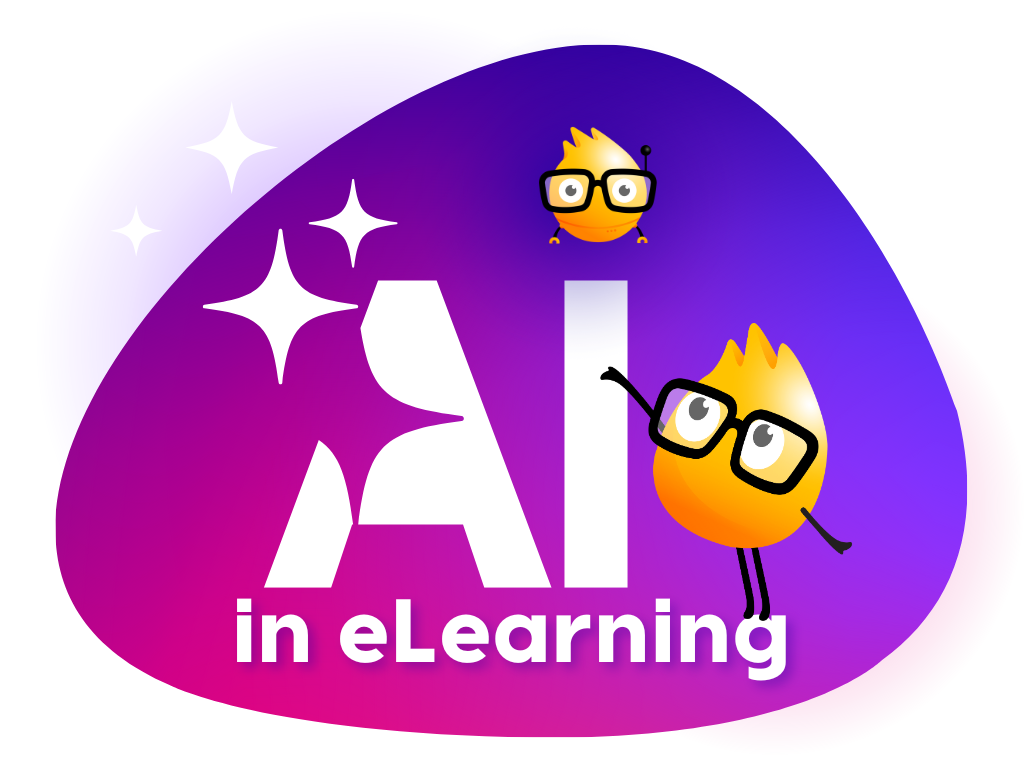10 Binge-worthy, Must-watch Learning Trends this Fall
In the Northern Hemisphere, it’s almost fall, which means that our favorite TV shows are back! Cliffhangers, romance, laughs, drama:...
Exploring AI-powered learning platforms but not sure where to start? This resource is your hub for understanding how artificial intelligence is reshaping learning and development (L&D) across industries. AI is driving efficiency by automating tasks, creating personalized learning paths, and using data to guide smarter training decisions at scale.
You’ll explore:

Artificial intelligence (AI) is transforming how organizations train, upskill, and engage their workforce. Across industries, AI-powered learning platforms are becoming essential parts of modern tech stacks, improving operational efficiency, enabling data-driven decisions, and fueling innovation.
For L&D and HR leaders, the priority is creating scalable and adaptive training programs that can keep pace with constant change. The solution? An AI learning platform that automates the creation, delivery, and management of training content while optimizing learning outcomes for every employee.
Modern workplaces increasingly rely on AI in learning and development (L&D) to support self-directed and personalized learning. By giving employees the tools to identify skill gaps, set learning goals, and access relevant training materials, organizations can boost engagement, improve knowledge retention, and reduce turnover.
Autonomous learning in the workplace empowers employees to identify needs, set goals, and engage with resources that align with their objectives.
AI-driven, self-guided learning shifts training from external teams to the individual employees. Programs can be adapted to specific needs with features like real-time feedback, adaptive pathways, gamification, and simulations that enhance performance. At the same time, businesses benefit from stronger talent retention, higher productivity, and measurable ROI from training investments.
By leveraging an AI learning platform, employees are empowered to learn autonomously at their own pace and adjust without feeling overwhelmed.

The future of L&D is being shaped by major advances happening in AI, driving the next wave of workplace training innovation. Organizations are adopting AI tools not only to close skill gaps but also to forecast workforce needs, personalize development plans, and improve long-term career growth opportunities.
According to a recent Litmos survey of 1,000 workers across industries, the most sought-after AI LMS features include personalized learning paths by role, intelligent skill assessments, and real-time feedback that adapts to learner performance. These capabilities reflect the growing expectation that training should be tailored to each employee’s career trajectory rather than delivered through one-size-fits-all programs.
The survey also revealed that modern learners are motivated more by opportunities for advancement and skill growth than by short-term incentives. This trend underscores why organizations must align their learning strategies with career development, reskilling, and retention goals to remain competitive.
How AI is reshaping workplace learningDid you know that 58.4% of workers who currently use AI would also like to see more personalized training experiences?
AI is reshaping how organizations design, deliver, and evolve training programs. By improving both content development and learner engagement, AI-powered learning solutions give L&D teams the ability to future-proof their workforce, retain top talent, and adapt training to shifting business needs.
Instructional designers and L&D leaders can use AI to accelerate content development while maintaining quality. Instead of spending time on manual drafting and research, AI tools handle repetitive tasks so experts can focus on strategy, creativity, and alignment with business goals. The result is faster program launches, consistent content quality, and a more responsive learning experience.

Today’s learners want autonomy, personalization, and measurable growth. AI platforms empower employees to take ownership of their development while still delivering guidance, feedback, and coaching. This not only supports employee development but also helps organizations achieve higher engagement, stronger retention, and measurable ROI from training programs.
An AI-powered LMS transforms your content library from a static repository into a dynamic knowledge base. Instead of relying on rigid keyword searches, employees can use natural language to ask questions and surface the exact materials they need, right when they need them.
L&D leaders can quickly adapt courses to reflect regulatory changes, new product launches, or updated internal policies with our AI content authoring tool. Instead of spending weeks revising content manually, AI surfaces what needs to be refreshed and drafts updates so training libraries stay accurate and impactful.
Teams using AI authoring tools cut content update times from weeks to just days, keeping training accurate, relevant, and impactful.
Traditional training often leaves little room for practice and feedback, yet these elements are critical for building confidence and transferring knowledge to real-world scenarios. AI-enabled video assessments allow learners to safely rehearse skills and receive immediate, targeted feedback.
Go beyond search and discovery by actively shaping each employee’s growth path. Instead of navigating a catalog, learners can request training that fits their career goals, project needs, or certification requirements and instantly receive a curated sequence of resources designed just for them with AI-powered playlists.
The use of AI in learning often involves the collection and analysis of large amounts of learner data, which can lead to privacy concerns. Litmos prioritizes privacy in its AI development process, ensuring that data is handled securely and in compliance with relevant regulations. Litmos only uses customer information for its intended purposes and adheres to strict privacy policies, assuring data confidentiality. Our goal is to build trust in our AI-enabled services through a continued commitment to privacy.
Privacy is our priority so customer data is never used to train the Litmos AI model.
Our proprietary AI infrastructure provides granular control, so administrators can choose what course content the AI Assistant uses. The infrastructure that Litmos AI Assistant is built on is GDPR, SOC II, CCPA compliant and will never share customer data outside of the customer tenant.
AI algorithms can unintentionally reflect or amplify biases if they are trained on incomplete or unbalanced data. In a learning environment, this can result in unequal access to opportunities, inconsistent recommendations, or unfair treatment of certain groups of learners.
At Litmos, we prioritize responsible AI development by embedding ethics into every stage of our process. Our comprehensive risk management framework includes strict guidelines for data sourcing, model training, and system evaluation to minimize bias and promote fairness. A dedicated ethics component ensures that new AI features are reviewed not only for accuracy and performance but also for their social and organizational impact. Our goal is to deliver technology that is innovative as well as equitable, transparent, and aligned with our customers’ values.

One of the most common concerns about AI in learning is that leaning on it too heavily can weaken effectiveness. When AI takes over too much of the process, organizations risk losing the human judgment, empathy, and context that are essential for complex decision-making. At the learner level, over-reliance on AI tools may also reduce opportunities for critical thinking by encouraging shortcuts instead of deeper engagement.
To mitigate these risks, Litmos addresses these concerns by giving administrators control over how AI tools are used. For example, admins can restrict instant course summaries until a learner has completed the training. When summaries are enabled, they always include citations so learners can return to the original content and strengthen their understanding. Our training library offers courses on the ethical use of AI in the workplace and the role of human oversight. These resources guide teams in adopting AI responsibly, building confidence in how to collaborate effectively with AI tools while maintaining accountability and trust.
Learners are motivated not only by content but also by the human connection that comes from coaching, feedback, and encouragement. AI can’t replicate empathy or understand the emotional drivers that keep people engaged. That’s why L&D professionals remain essential in interpreting learner needs and creating experiences that resonate on a personal level. Litmos supports this balance by combining AI-driven efficiency with human-led strategies that keep learners inspired and connected.
The learning platform you select sets the foundation for how employees engage with training and how leaders measure success. With dozens of vendors promising innovation, it’s important to evaluate options with a structured lens that balances features, budget, integrations, and organizational alignment.
When comparing AI-powered platforms, it’s easy to get lost in flashy promises. Instead of focusing on hype, zero in on the features that actually improve learning, streamline administration, and protect your data. These capabilities not only define a modern LMS but also ensure your investment drives measurable impact.
| Feature | Why it matters | Use case examples |
|---|---|---|
| Personalized learning | Delivers training tailored to role, skills, and goals | New hires see content matched to their career path |
| Content authoring | Speeds updates and creates new materials | Generate course outlines or assessments in minutes |
| Automated feedback | Provides instant, objective learner insights | Video submissions graded with real-time suggestions |
| Admin automation | Reduces manual workload | Auto-enroll users, schedule sessions and generate reports |
| Data security | Protects proprietary info | Ensure AI doesn’t train on your internal content |
| Traceability & accuracy | Builds trust in AI outputs | Learners can check citations and source material |

Before you begin comparing AI LMS vendors, it’s crucial to align your internal team. Bring IT, HR, L&D, and business managers together early and use these prompts to guide discussion:
Factor in long-term ROI, user adoption, integration costs, and scalability when budgeting for an LMS.
Crafting a strong business case for your LMS is essential to earning executive approval and cross-departmental support.
When learning is positioned as a driver of ROI and organizational growth, it reframes the investment as a strategic advantage instead of a cost center.

AI can accelerate learning outcomes, but adoption depends on change management, enablement, and clear governance. Use the table and checklist below to turn interest into results.
| Challenge | Organizational impact | How to solve it |
|---|---|---|
| Change resistance | Hesitation to try AI, fear of job loss | Communicate role-specific benefits, spotlight peer success |
| Skills gap | Teams lack AI know-how or confidence | Deliver role-based training, job aids, office hours, and resources |
| Content quality | Outdated courses, poor search results | Standardize taxonomies, refresh content with AI authoring |
| Workflow fit | AI tools sit outside daily processes | Integrate with HRIS and productivity tools, automate reporting |
| Governance | Unclear rules, audit or output concerns | Define usage policies, require human review and source citations |
| ROI clarity | Anecdotal wins, budget pushback | Tie AI adoption to KPIs like ramp time, retention, and support resolution |
Implementing an LMS at scale requires more than flipping a switch. A structured pilot helps validate use cases, build internal momentum, and reduce risks before expanding to the entire organization. By starting small, proving value, and then phasing growth, you create a foundation for long-term adoption and measurable impact.
The following steps outline how to structure a pilot that scales effectively:

An AI-powered LMS delivers measurable value to a wide range of stakeholders across the organization. From individual employees to senior leadership, these platforms automate tasks, personalize learning, and provide insights that strengthen performance and business outcomes.
AI creates personalized, adaptive learning paths that make training more relevant and engaging for busy professionals. This leads to stronger skill development, higher satisfaction, and improved retention specific to their role.
Key benefits:
For lean or busy L&D teams, AI reduces manual effort and accelerates program delivery. By automating administrative tasks and supporting rapid content creation, teams can focus on strategy and learner success.
Key benefits:
AI-driven insights give leaders visibility into workforce performance while also supporting employee and leadership development. By tying training to business outcomes and career growth, executives can improve retention, strengthen leadership pipelines, and drive overall organizational performance.
Key benefits:
AI tools help designers and trainers deliver engaging, high-quality content at scale. AI-powered video assessments that provide instant feedback individualize coaching, while authoring tools speed up development cycles.
Key benefits:
AI-powered LMS platforms extend value beyond the workforce. They streamline external training, compliance, and onboarding, helping organizations strengthen customer loyalty and partner performance.
Key benefits:

From enterprise-level complexity to mid-market agility, AI adapts to deliver the right balance of consistency, personalization, and efficiency for your workforce. Whether your organization needs to scale training across global regions or optimize onboarding with a leaner L&D team, an AI-driven LMS can flex to meet your goals.
Large enterprises face the challenge of delivering consistent learning across global workforces while still personalizing experiences to diverse roles and regions. AI-enabled platforms make it possible to scale efficiently without sacrificing relevance.
Key benefits:
For mid-market organizations, agility and efficiency are top priorities. AI-powered LMS platforms enable cost-effective training strategies, from streamlined onboarding to rapid reskilling, without requiring large L&D teams.
Key benefits:
Adopting an AI-driven LMS is more than a tech upgrade. It is a long-term strategy for transforming how your organization learns and grows. A clear roadmap helps you move from exploration to rollout with confidence, ensuring sustainable adoption and measurable results.

In the Northern Hemisphere, it’s almost fall, which means that our favorite TV shows are back! Cliffhangers, romance, laughs, drama:...
What is Self-Directed Learning and Why Does It Matter Now? Self-directed learning is an instructional approach in which individuals take...
When OpenAI’s generative chatbot, ChatGPT, launched in late 2022, it took the world by storm. Artificial Intelligence (AI) has been...